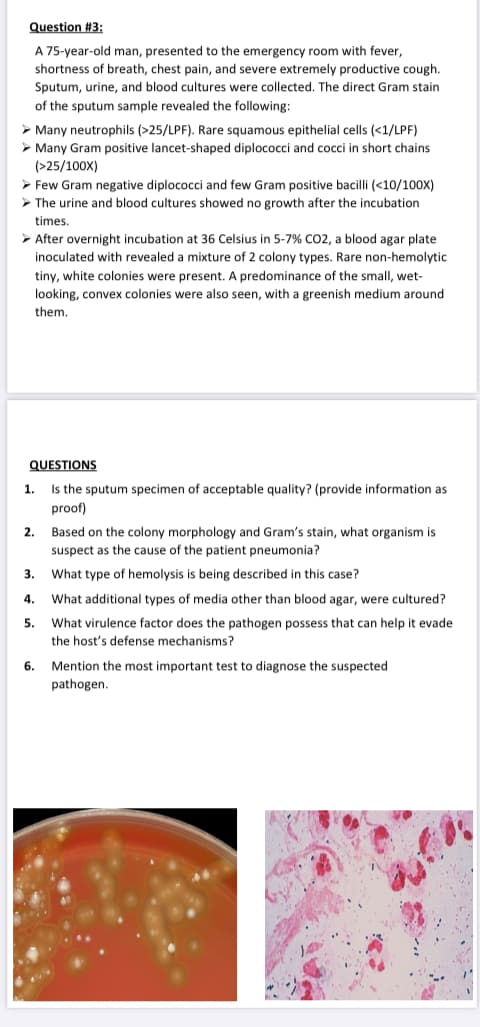Question #3: A 75-year-old man, presented to the emergency room with fever, shortness of breath, chest pain, and severe extremely productive cough. Sputum, urine, and blood cultures were collected. The direct Gram stain of the sputum sample revealed the following: > Many neutrophils (>25/LPF). Rare squamous epithelial cells (<1/LPF) > Many Gram positive lancet-shaped diplococci and cocci in short chains (>25/100X) > Few Gram negative diplococci and few Gram positive bacilli (<10/100X) > The urine and blood cultures showed no growth after the incubation times. > After overnight incubation at 36 Celsius in 5-7% CO2, a blood agar plate inoculated with revealed a mixture of 2 colony types. Rare non-hemolytic tiny, white colonies were present. A predominance of the small, wet- looking, convex colonies were also seen, with a greenish medium around them. QUESTIONS 1. Is the sputum specimen of acceptable quality? (provide information as proof) 2. Based on the colony morphology and Gram's stain, what organism is suspect as the cause of the patient pneumonia? 3. What type of hemolysis is being described in this case?
Question #3: A 75-year-old man, presented to the emergency room with fever, shortness of breath, chest pain, and severe extremely productive cough. Sputum, urine, and blood cultures were collected. The direct Gram stain of the sputum sample revealed the following: > Many neutrophils (>25/LPF). Rare squamous epithelial cells (<1/LPF) > Many Gram positive lancet-shaped diplococci and cocci in short chains (>25/100X) > Few Gram negative diplococci and few Gram positive bacilli (<10/100X) > The urine and blood cultures showed no growth after the incubation times. > After overnight incubation at 36 Celsius in 5-7% CO2, a blood agar plate inoculated with revealed a mixture of 2 colony types. Rare non-hemolytic tiny, white colonies were present. A predominance of the small, wet- looking, convex colonies were also seen, with a greenish medium around them. QUESTIONS 1. Is the sputum specimen of acceptable quality? (provide information as proof) 2. Based on the colony morphology and Gram's stain, what organism is suspect as the cause of the patient pneumonia? 3. What type of hemolysis is being described in this case?
Biochemistry
9th Edition
ISBN:9781319114671
Author:Lubert Stryer, Jeremy M. Berg, John L. Tymoczko, Gregory J. Gatto Jr.
Publisher:Lubert Stryer, Jeremy M. Berg, John L. Tymoczko, Gregory J. Gatto Jr.
Chapter1: Biochemistry: An Evolving Science
Section: Chapter Questions
Problem 1P
Related questions
Question

Transcribed Image Text:Question #3:
A 75-year-old man, presented to the emergency room with fever,
shortness of breath, chest pain, and severe extremely productive cough.
Sputum, urine, and blood cultures were collected. The direct Gram stain
of the sputum sample revealed the following:
> Many neutrophils (>25/LPF). Rare squamous epithelial cells (<1/LPF)
> Many Gram positive lancet-shaped diplococci and cocci in short chains
(>25/100X)
> Few Gram negative diplococci and few Gram positive bacilli (<10/100X)
> The urine and blood cultures showed no growth after the incubation
times.
> After overnight incubation at 36 Celsius in 5-7% CO2, a blood agar plate
inoculated with revealed a mixture of 2 colony types. Rare non-hemolytic
tiny, white colonies were present. A predominance of the small, wet-
looking, convex colonies were also seen, with a greenish medium around
them.
QUESTIONS
Is the sputum specimen of acceptable quality? (provide information as
proof)
1.
2.
Based on the colony morphology and Gram's stain, what organism is
suspect as the cause of the patient pneumonia?
3.
What type of hemolysis is being described in this case?
4.
What additional types of media other than blood agar, were cultured?
5.
What virulence factor does the pathogen possess that can help it evade
the host's defense mechanisms?
6.
Mention the most important test to diagnose the suspected
pathogen.
Expert Solution
This question has been solved!
Explore an expertly crafted, step-by-step solution for a thorough understanding of key concepts.
This is a popular solution!
Trending now
This is a popular solution!
Step by step
Solved in 2 steps

Knowledge Booster
Learn more about
Need a deep-dive on the concept behind this application? Look no further. Learn more about this topic, biochemistry and related others by exploring similar questions and additional content below.Recommended textbooks for you

Biochemistry
Biochemistry
ISBN:
9781319114671
Author:
Lubert Stryer, Jeremy M. Berg, John L. Tymoczko, Gregory J. Gatto Jr.
Publisher:
W. H. Freeman

Lehninger Principles of Biochemistry
Biochemistry
ISBN:
9781464126116
Author:
David L. Nelson, Michael M. Cox
Publisher:
W. H. Freeman

Fundamentals of Biochemistry: Life at the Molecul…
Biochemistry
ISBN:
9781118918401
Author:
Donald Voet, Judith G. Voet, Charlotte W. Pratt
Publisher:
WILEY

Biochemistry
Biochemistry
ISBN:
9781319114671
Author:
Lubert Stryer, Jeremy M. Berg, John L. Tymoczko, Gregory J. Gatto Jr.
Publisher:
W. H. Freeman

Lehninger Principles of Biochemistry
Biochemistry
ISBN:
9781464126116
Author:
David L. Nelson, Michael M. Cox
Publisher:
W. H. Freeman

Fundamentals of Biochemistry: Life at the Molecul…
Biochemistry
ISBN:
9781118918401
Author:
Donald Voet, Judith G. Voet, Charlotte W. Pratt
Publisher:
WILEY

Biochemistry
Biochemistry
ISBN:
9781305961135
Author:
Mary K. Campbell, Shawn O. Farrell, Owen M. McDougal
Publisher:
Cengage Learning

Biochemistry
Biochemistry
ISBN:
9781305577206
Author:
Reginald H. Garrett, Charles M. Grisham
Publisher:
Cengage Learning

Fundamentals of General, Organic, and Biological …
Biochemistry
ISBN:
9780134015187
Author:
John E. McMurry, David S. Ballantine, Carl A. Hoeger, Virginia E. Peterson
Publisher:
PEARSON